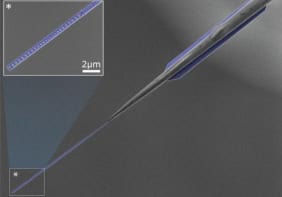The backbone of the world's communication system is a network of optical fibres that carry information in the form of light pulses. Large volumes of data can be transmitted very efficiently down these fibres but bottlenecks in the system occur when the light pulses are converted into electrical signals at various "junction boxes" that ensure information reaches its correct destination. The telecommunications industry, among others, is therefore extremely interested in microphotonic circuits that can manipulate light pulses directly and therefore increase data rates.

Physicists in Denmark and France led by Sergey Bozhevolnyi of the University of Aalborg have developed a new class of waveguide that could get round one of the biggest obstacles to photonic circuits. The devices allow light at telecommunications wavelengths to be “squeezed” to below the diffraction limit, allowing it to pass though small regions such as channels on a chip without being significantly lost (Nature 440 508).
Diffraction means that only a tiny amount of light can pass through a hole that is narrower than the wavelength of the light, and the light that is transmitted emerges in all directions. This can be problematic, for example, in optical lithography where diffraction prevents the fabrication of semiconductor features below a certain size. In telecommunications, where the light typically has a wavelength of 1.5 microns, light cannot pass though the channels used to guide electrons in today’s silicon chips because they are too small.
One way to overcome this problem is to use light waves to excite the collective wavelike motions of billions of electrons on the surface of metals. Unlike the light waves themselves, these “surface plasmons” are not restricted by the diffraction limit of light. Indeed, Bozhevolnyi and co-workers previously showed that the plasmons can be used to guide light through grooves in gold that are much narrower than the wavelength of the light used.
Now, the Denmark-France team has taken this work a step further by using a new class of surface plasmons called channel plasmon-polaritons — electromagnetic waves that originate at the interface of a metal and an insulating dielectric such as air. The researchers have shown that these plasmons can guide and manipulate light along the bottom of sub-wavelength V-shaped grooves in a gold film without significant propagation losses (see figure). This is because the surface plasmons remain tightly bound to the interface and thus concentrate the light into a volume that is less than one wavelength across.
Channel plasmon-polaritons can be used to transmit light signals for wavelengths of around 1.5 microns — just right for telecommunications applications. Furthermore, the propagation length of a plasmon at a planar gold-air interface is around 1mm, which is long enough to optically connect two devices on a chip.
“Our technique is so good that it can already be used for many practical applications, such as ultracompact optical interconnects, interferometers and waveguide-ring resonators,” explains Bozhevolnyi. “It should also be borne in mind that the channel plasmon-polaritons are bound to and propagate along the metal surface, thereby allowing for natural integration with electrical circuits.”




